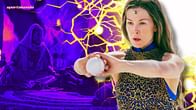Happy Face: Who is Hazel Reed based on? Explained

Paramount's newest crime thriller series, Happy Face, which was released on the streaming platform on March 20, 2025, has aired its fourth episode today. The series follows the story of Melissa Moore, who is the daughter of Keith Hunter Jesperson, infamously known as the Happy Face killer.
The crime drama series explores Moore's past and present, as well as her relationship with her father, delving into themes of family and generational trauma, which is portrayed through the character of Melissa Reed. Reed is inspired by Melissa Moore. As the narrative progresses, we see in the series how Melissa’s daughter, Hazel, also becomes engulfed and enticed by her grandfather’s persona despite her mother's displeasure.
In the series, we saw how Jesperson comes out with his ninth murder confession and how things get more complicated with Hazel growing distant from her mother. She embarked on a dark path of her own prompted by her innocent teenage rebellion. While the character of Hazel is fictional, she is inspired by Melissa Moore's daughter, Aspen.
Hazel Reed is based on Melissa Moore’s Daughter in Happy Face
Happy Face is a dramatization of the real-life case of Keith Hunter Jesperson, who is also known as the Happy Face killer. While the series is based on the facts of the case, the characters are dramatized. Their names are changed but they are based on real people from Jesperson's life.
Despite being focused on Melissa Moore’s life and her experiences growing up with her serial killer father, the series takes many creative liberties to layer the truth in fictional events. The character of Hazel is one of the best examples of this. Hazel is Moore’s first-born child and the elder sister of her brother Jake. Hazel is Melissa's firstborn in the Paramount series, and she has a younger brother named Max.
How much of the character of Hazel Reed is real?
In reality, Melissa Moore and her husband, Sam Moore, visited Jesperson in prison with their four-year-old daughter and infant son. However, in the series, we see that Hazel and Max have no idea that they have a grandfather named Keith Jesperson, let alone who he really is. The only time Hazel has any correspondence with her grandfather Jesperson is when he sends her cards on her birthday.
In reality, Moore claimed that Jesperson would send letters to her constantly, which she claimed she never read. But there is no information about whether Aspen received cards as Hazel did in the series. While it is clear that Hazel is inspired by Aspen, the character is semi-fictional in conception and has her own storylines, which strays sometimes from Aspen's story.
A significant aspect of Hazel's character arc is coming to terms with her grandfather’s crimes and eventually being inspired by him and growing closer to him despite her mother's warnings. In this series, we also see that she learns to sell his artwork online. This fact may not be fictional because a real-life community and market for Jespersen’s creative works exists. There are also museums where memorabilia linked with him and other serial killers are displayed for public viewing.
The series thus is based on reality but does not shy away from fictionalizing where necessary and we see a lot of this happening in the case of Hazel Reed's character. This also adds some complexity and depth to the story, making it engaging and interesting for viewers.
Catch Happy Face on Paramount Plus today.




